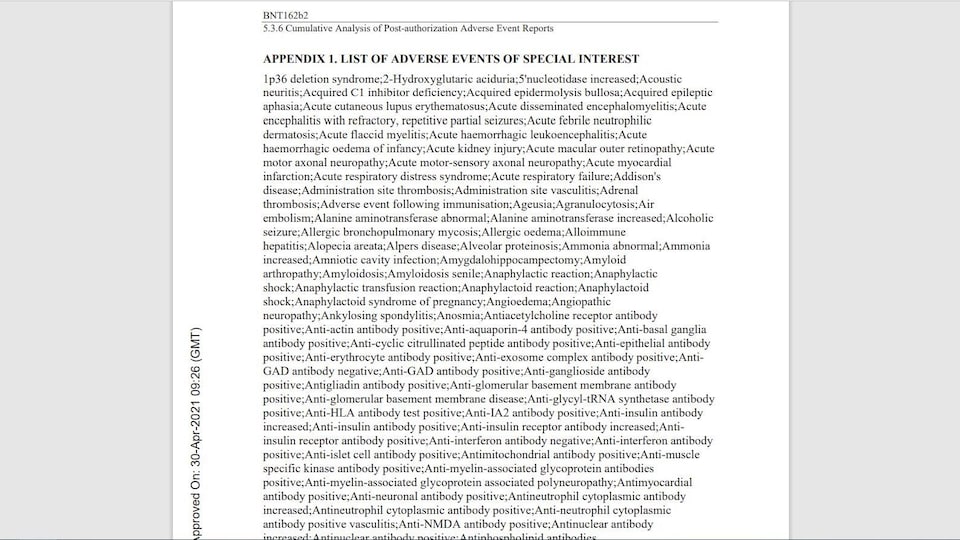On social networks, there are many alleged “revelations” taken from documents used by the United States Medicines Agency (FDA) to approve the Pfizer-BioNTech vaccine against COVID-19.
If the documents, called “Pfizer documents” or ” Pfizer documents “Of many Internet users, exists, they do not prove that the pharmaceutical company has hidden the risks associated with its vaccine from the general public or that many side effects are not listed.
Additionally, some of the new information that people say has been taken from these documents over the past few weeks has become public within a few months or come from other sources.
What are these documents and why were they made public?
At the time of writing these lines, there are 238 documents, which can be downloaded from the site (New window) from Public Health and Medical Professionals for Transparency (PHMPT), a collective claimed to have its mission obtain and disseminate data that the FDA hopes to authorize vaccines against COVID-19.
They contain, among other things, information obtained from clinical studies, but also pharmacovigilance data on the side effects of vaccines after their distribution to the general population.
In September 2021, the collective filed a lawsuit in Texas court to obtain these 329,000 pages from the FDA after, according to it, the agency refused. (New window)its original request made under the U.S. Freedom of Information Act.
The joint plaintiffs wanted to release all documents before March 3, 2022, when the FDA proposed to release 500 pages per month (New window)a formula that would have spread the distribution of these hundreds of thousands of pages over 55 years.
The agency said it needed time to review each of the documents and redact any personal information, but a judge ruled earlier this year that more than 12,000 pages should be made public before January. 31, 2022, and that another 55,000 must be paid every 30 days from 1eh march.
Result: more than 80,000 pages are now available, and the entire process should be completed by the end of the year.
In other words, contrary to what many Internet users say, this is not a leak of confidential documents, but the result of a court order.
And whenever new documents are made public, the temptation of misinformation is not far off.
Do the documents show any unknown side effects?
No, but it did not stop the spread of misinformation about it.
A list of 1291 side effects (New window) covering nine pages was, for example, misrepresented as a list of side effects caused by the vaccine, but instead it compiled pharmacovigilance data from many countries that could not be caused by the association. in the vaccine, as explained by Reuters (New window).
The Vaccine Adverse Effects Report System (VAERS) from the United States is one of the best-known and most frequently cited pharmacovigilance systems related to the COVID-19 vaccine. It lists adverse events that occur after vaccination reported by health care professionals or by patients in the country.
As mentioned by VAERS on his website (New window), A VAERS report generally does not confirm that the identified vaccine (s) caused the adverse event described and, therefore, that the vaccine was responsible for the death. This only confirms that the reported event occurred a few hours after the vaccine was given..
Pharmacovigilance data is a source of so much misinformation that has fueled the prevalence of side effects since the start of vaccination campaigns around the world, as reported several times by Decryptors.
Note that this document is not new. It was among the first to be sent to PHMPT in November 2021, but it continues to reappear from time to time. This was notably discussed in a viral video on YouTube (New window) uploaded on May 9 by the far-right French radio channel Radio-Courtoisie, where geneticist Alexandra Henrion-Caude was interviewed, who has already spread misinformation about vaccines. The video has been viewed over 435,000 times.
Do the documents prove that the vaccine is only 12% effective?
No, this efficiency rate does not appear anywhere in the Pfizer documents.
Epidemiologist Gideon Meyerowitz-Katz (New window) and biomedical data scientist Jeffrey Morris (New window) tried to trace the source of this rumor that spread on social networks in early May. They concluded it was based on a miscalculation, based on an FDA document that has been available to the public since 2020 (New window) (which therefore has nothing to do with Pfizer documents) and that it was first published in a post (New window) on the Substack platform.
The author of this post compared the number of COVID-19 cases suspicious but not confirmed to vaccinated (1594 people) and non -vaccinated (1816 people) participants in the trials described in the cited document. So he decided that the vaccine only protects 12%.
However, the clinical trial protocol (New window) (section 8.13) indicates that these cases suspicious but not confirmed can take a PCR test and the symptoms that show a suspected case can also be side effects of the vaccine. This means that the cases suspicious but not confirmed are not necessarily cases of COVID-19, as a side effect reported in a pharmacovigilance system is not necessarily caused by the vaccine.
At the time, these clinical trials concluded that the Pfizer vaccine was 95% effective against symptomatic disease with the original SARS-CoV-2 strain. Since then, variants have come to change the game: a recent report (New window) from the UK Health Safety Agency indicates that this vaccine offers 65% to 70% protection against the symptomatic disease with the Omicron variant after two doses, and it drops to approximately 15% after 25 week. It increases between 60% and 75% after the booster dose.
According to this same report, the vaccine provides substantial protection against hospitalizations (82.4% after booster dose, 53.6% after 15 weeks) and death (93.6% after booster dose, 87.6% after 10 weeks and more).
Do the documents show that the vaccine is not recommended for pregnant women?
No, these are screenshots of old information taken out of context. Screenshots of a document stating the vaccine is not recommended during pregnancy and that we do not know him is excreted in milk the mother actually came from a vaccine information sheet (New window) published by the UK Medicines Regulatory Agency in December 2020.
The vaccine has not been tested on pregnant women before, and these documents are no longer new.
The reality today is somewhat different: an agency spokesman told fact-checking media Full Truth (New window) na new data (both non-clinical data and post-authorization “real world” data) support updated vaccination advice for pregnant and lactating women.
The Canadian National Advisory Committee on Immunization (NACI) now recommends that women who are planning a pregnancy, who are pregnant or breastfeeding be vaccinated against COVID-19.
The COVID-19 vaccine can help prevent chronic diseases, hospitalizations and complications in pregnancy. There is growing evidence on the safety and effectiveness of COVID-19 vaccination in pregnancycan we read on the CCNI website (New window)reminding that hundreds of thousands of women in these situations around the world have received these vaccines.
There is information from Full Fact, Reuters and AFP Factual

Source: Radio-Canada


